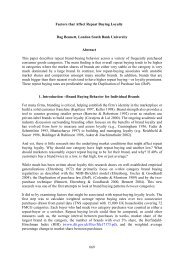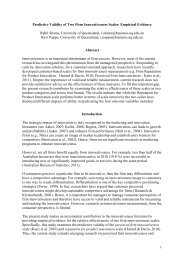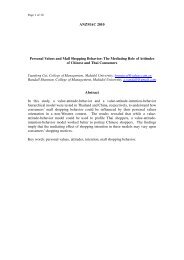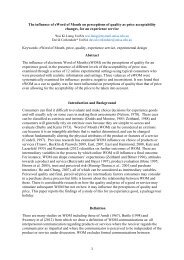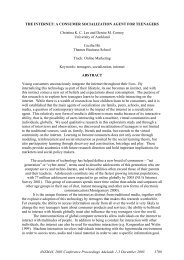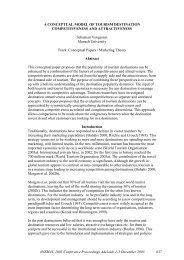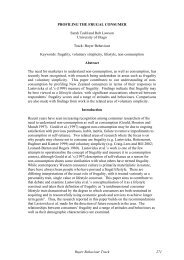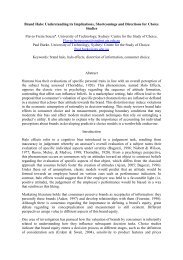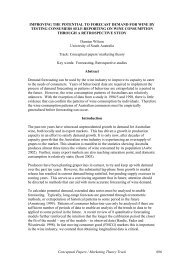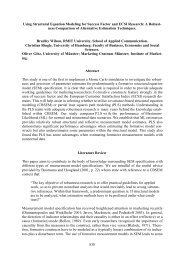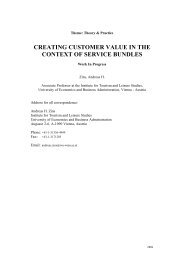Building Friendships and Relationships: The Role of ... - anzmac
Building Friendships and Relationships: The Role of ... - anzmac
Building Friendships and Relationships: The Role of ... - anzmac
Create successful ePaper yourself
Turn your PDF publications into a flip-book with our unique Google optimized e-Paper software.
tests are a construction research technique (Papantoniou, 1992; Pearce, 2003; Malhotra &<br />
Peterson, 2006) requiring the respondent to ‘construct’ a response to a pictorially framed<br />
question “what did you talk about?” This selective recall was used to prompt the respondent<br />
in the interview that followed. Each participant was interviewed in a private area <strong>of</strong> salon. <strong>The</strong><br />
interviews explored the preceding service encounter conversation from the client’s<br />
perspective. <strong>The</strong> three-pronged research design allowed examination from multiple<br />
viewpoints (Neuman, 2006).<br />
Service conversations were drawn from encounters in an outer western Sydney hairdressing<br />
salon, a small business employing four hairdressers, three females <strong>and</strong> a male servicing both<br />
male <strong>and</strong> female clients. Located in an area recognised for its concentration <strong>of</strong> small<br />
hairdressing salons, the salon <strong>of</strong>fers a full range <strong>of</strong> hair services <strong>and</strong> has operated for 25 years.<br />
Demographics <strong>of</strong> the salon’s clientele were noted <strong>and</strong> client records were examined to select<br />
participants representing “typical” clients ranging from ‘short’ to ‘long’ term. Encounters may<br />
vary with the type <strong>of</strong> hair salon (Lawson, 1999). <strong>The</strong>se can range from large franchise chains<br />
with a price <strong>and</strong> time focus to up-market stylists. This salon is in a middle- price range, <strong>and</strong><br />
full service.<br />
In order to ensure a desirable degree <strong>of</strong> sample diversity (Patton, 1990), quota sampling<br />
(Neuman, 2006) was used to select eight customers <strong>and</strong> their service encounters. Variables<br />
that defined quota categories were gender <strong>and</strong> relationship length. Gender was chosen because<br />
gender composition <strong>of</strong> the customer-service employee pairing was likely to influence the<br />
nature <strong>and</strong> possibly role <strong>of</strong> conversation (Brotherton & Penman, 1977; Hall & Braunwald,<br />
1981). <strong>The</strong> length <strong>of</strong> relationship between customer <strong>and</strong> hairdresser was also selected because<br />
duration can influence conversation intimacy (Altman & Taylor, 1973). Short-term customers<br />
(n=4) were defined as those patronizing the salon for two years or less, whilst long term<br />
customers (n=4) were defined as patrons <strong>of</strong> five years or more. Two durations were selected<br />
on the assumption that customers who had patronized the salon for two years or less would<br />
have different, possibly less personal relationships with their hairdressers than those<br />
customers who had patronized the salon for five years or more. <strong>The</strong> encounters examined<br />
involved two long-serving employees (male <strong>and</strong> female), each servicing two male <strong>and</strong> two<br />
female customers.<br />
Employees were briefed on their potential inclusion in the study by both the business owners<br />
<strong>and</strong> the researcher. Staff involvement was limited to audio-recording their conversations with<br />
selected customers during the service encounter. When salon clients - potential research<br />
participants - telephoned to make an appointment they were informed <strong>of</strong> the study <strong>and</strong> asked<br />
whether they would like to participate. Consenting customers were eventually introduced to<br />
the researcher. Service encounter conversations between hairdresser <strong>and</strong> client were discreetly<br />
recorded using a digital audio device.<br />
Results <strong>and</strong> Discussion<br />
Conversation was generally present during the entire duration <strong>of</strong> each service encounter. All<br />
conversation topics were mapped <strong>and</strong> themed. Eighty one topic categories were identified.<br />
Service or task- oriented service conversation had the highest frequency <strong>of</strong> conversation<br />
categories but accounted for only 7 per cent <strong>of</strong> all conversation topics. Social conversation<br />
topics dominated the conversations <strong>of</strong> both short <strong>and</strong> long term clients. Conversations<br />
generally progressed from a greeting <strong>and</strong> service related talk, a follow up or reference to



